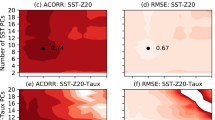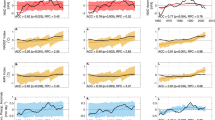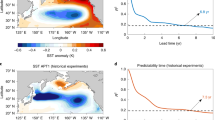Abstract
Forecasts of El Niño climate events are routinely provided and distributed, but the limits of El Niño predictability are still the subject of debate. Some recent studies suggest that the predictability is largely limited by the effects of high-frequency atmospheric ‘noise’1,2,3,4,5,6,7, whereas others emphasize limitations arising from the growth of initial errors in model simulations8,9,10. Here we present retrospective forecasts of the interannual climate fluctuations in the tropical Pacific Ocean for the period 1857 to 2003, using a coupled ocean–atmosphere model. The model successfully predicts all prominent El Niño events within this period at lead times of up to two years. Our analysis suggests that the evolution of El Niño is controlled to a larger degree by self-sustaining internal dynamics than by stochastic forcing. Model-based prediction of El Niño therefore depends more on the initial conditions than on unpredictable atmospheric noise. We conclude that throughout the past century, El Niño has been more predictable than previously envisaged.
This is a preview of subscription content, access via your institution
Access options
Subscribe to this journal
Receive 51 print issues and online access
$199.00 per year
only $3.90 per issue
Buy this article
- Purchase on Springer Link
- Instant access to full article PDF
Prices may be subject to local taxes which are calculated during checkout




Similar content being viewed by others
References
Fedorov, A. V., Harper, S. L., Philander, S. G., Winter, B. & Wittenberg, A. How predictable is El Niño? Bull. Am. Meteorol. Soc. 84, 911–919 (2003)
Penland, C. & Sardeshmukh, P. D. The optimal growth of tropical sea surface temperature anomalies. J. Clim. 8, 1999–2024 (1995)
Moore, A. M. & Kleeman, R. Stochastic forcing of ENSO by the intraseasonal oscillation. J. Clim. 12, 1199–1220 (1999)
Thompson, C. J. & Battisti, D. S. A linear stochastic dynamical model of ENSO. Part I: Model development. J. Clim. 13, 2818–2832 (2000)
Perigaud, C. M. & Cassou, C. Importance of oceanic decadal trends and westerly wind bursts for forecasting El Niño. Geophys. Res. Lett. 27, 389–392 (2000)
McPhaden, M. J. & Yu, X. Equatorial waves and the 1997/98 El Niño. Geophys. Res. Lett. 26, 2961–2964 (1999)
Boulanger, J. P. et al. Role of non-linear oceanic processes in the response to westerly wind events: New implications for the 1997 El Niño onset. Geophys. Res. Lett. 28, 1603–1606 (2001)
Goswami, B. N. & Shukla, J. Predictability of a coupled ocean-atmosphere model. J. Clim. 4, 3–22 (1991)
Chen, D., Zebiak, S. E., Busalacchi, A. J. & Cane, M. A. An improved procedure for El Niño forecasting: implications for predictability. Science 269, 1699–1702 (1995)
Xue, Y., Cane, M. A. & Zebiak, S. E. Predictability of a coupled model of ENSO using singular vector analysis. Part I: Optimal growth in seasonal background and ENSO cycles. Mon. Weath. Rev 125, 2043–2056 (1997)
Barnston, A. G., Glantz, M. H. & He, Y. X. Predictive skill of statistical and dynamical climate models in SST forecasts during the 1997/98 El Niño episode and the 1998 La Niña onset. Bull. Am. Meteorol. Soc. 80, 217–243 (1999)
Kaplan, A. et al. Analysis of global sea surface temperature 1856–1991. J. Geophys. Res. 103, 18567–18589 (1998)
Chang, P., Ji, L., Li, H. & Flugel, M. Chaotic dynamics versus stochastic processes in El Niño-Southern Oscillation in coupled ocean-atmosphere models. Physica D 98, 301–320 (1996)
Latif, M. et al. A review of the predictability and prediction of ENSO. J. Geophys. Res. 103, 14375–14393 (1998)
Zebiak, S. E. & Cane, M. A. A model El Niño-Southern Oscillation. Mon. Weath. Rev. 115, 2262–2278 (1987)
Cane, M. A., Zebiak, S. E. & Dolan, S. C. Experimental forecasts of El Niño. Nature 321, 827–832 (1986)
Jin, F. F., Neelin, J. D. & Ghil, M. El Niño on the devil's staircase — annual subharmonic steps to chaos. Science 264, 70–72 (1994)
Tziperman, E., Stone, L., Cane, M. A. & Jarosh, H. El Niño chaos: overlapping of resonances between the seasonal cycle and the Pacific ocean-atmosphere oscillator. Science 264, 72–74 (1994)
Zebiak, S. E. On the 30–60 day oscillation and the prediction of El Niño. J. Clim. 2, 1381–1387 (1989)
Kirtman, B. P. & Schopf, P. S. Decadal variability in ENSO predictability and prediction. J. Clim. 11, 2804–2822 (1998)
Balmaseda, M. A., Davey, M. K. & Anderson, D. L. T. Decadal and seasonal dependence of ENSO prediction skill. J. Clim. 8, 2705–2715 (1995)
Davis, M. Late Victorian Holocausts: El Niño Famines and the Making of the Third World (Verso Books, New York, 2002)
Goddard, L. et al. Current approaches to climate prediction. Int. J. Climatol. 21, 1111–1152 (2002)
Jin, F. F. An equatorial ocean recharge paradigm for ENSO. Part I: Conceptual model. J. Atmos. Sci. 54, 811–829 (1997)
Meinen, C. S. & McPhaden, M. J. Observations of warm water volume changes in the equatorial Pacific and their relationship to El Niño and La Niña. J. Clim. 13, 3551–3559 (2000)
McPhaden, M. J. Tropical Pacific Ocean heat content variations and ENSO persistent barriers. Geophys. Res. Lett. 30, doi:10.1029/2003GL016872 (2003)
Kessler, W. S. EOF representation of the Madden-Julian Oscillation and its connection with ENSO. J. Clim. 14, 3055–3061 (2001)
Smith, T. M. & Reynolds, R. W. Extended reconstruction of global sea surface temperatures based on COADS data (1854–1997). J. Clim. 16, 1495–1510 (2003)
Rayner, N. A. et al. Globally complete analyses of sea surface temperature, sea ice and night marine air temperature, 1871–2000. J. Geophys. Res. 108, doi:10.1029/2002JD002670 (2003)
Chen, D., Cane, M. A., Zebiak, S. E., Canizares, R. & Kaplan, A. Bias correction of an ocean-atmosphere coupled model. Geophys. Res. Lett. 27, 2585–2588 (2000)
Acknowledgements
This Letter was written during the sabbatical leave of D.C. at the Laboratory of Ocean Dynamic Processes and Satellite Oceanography, Second Institute of Oceanography, Hangzhou, China. This work was supported by the National Oceanic and Atmospheric Administration, and by the National Aeronautics and Space Administration.
Author information
Authors and Affiliations
Corresponding author
Ethics declarations
Competing interests
The authors declare that they have no competing financial interests.
Rights and permissions
About this article
Cite this article
Chen, D., Cane, M., Kaplan, A. et al. Predictability of El Niño over the past 148 years. Nature 428, 733–736 (2004). https://doi.org/10.1038/nature02439
Received:
Accepted:
Issue Date:
DOI: https://doi.org/10.1038/nature02439
This article is cited by
-
Multi-scale spatial features and temporal attention mechanisms: advancing the accuracy of ENSO prediction
Intelligent Marine Technology and Systems (2024)
-
Multi-decadal variation of ENSO forecast skill since the late 1800s
npj Climate and Atmospheric Science (2023)
-
Development of Deep Convolutional Neural Network Ensemble Models for 36-Month ENSO Forecasts
Asia-Pacific Journal of Atmospheric Sciences (2023)
-
Sensitivity of El Niño diversity prediction to parameters in an intermediate coupled model
Climate Dynamics (2023)
-
Impact of atmospheric response of ENSO and IOD on boreal summer rainfall variability over the Indian Ocean in coupled models
Climate Dynamics (2023)
Comments
By submitting a comment you agree to abide by our Terms and Community Guidelines. If you find something abusive or that does not comply with our terms or guidelines please flag it as inappropriate.



